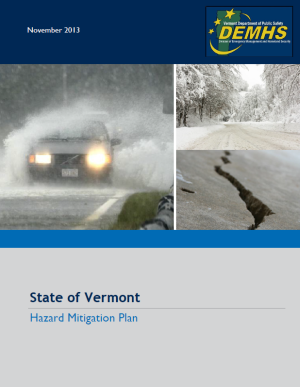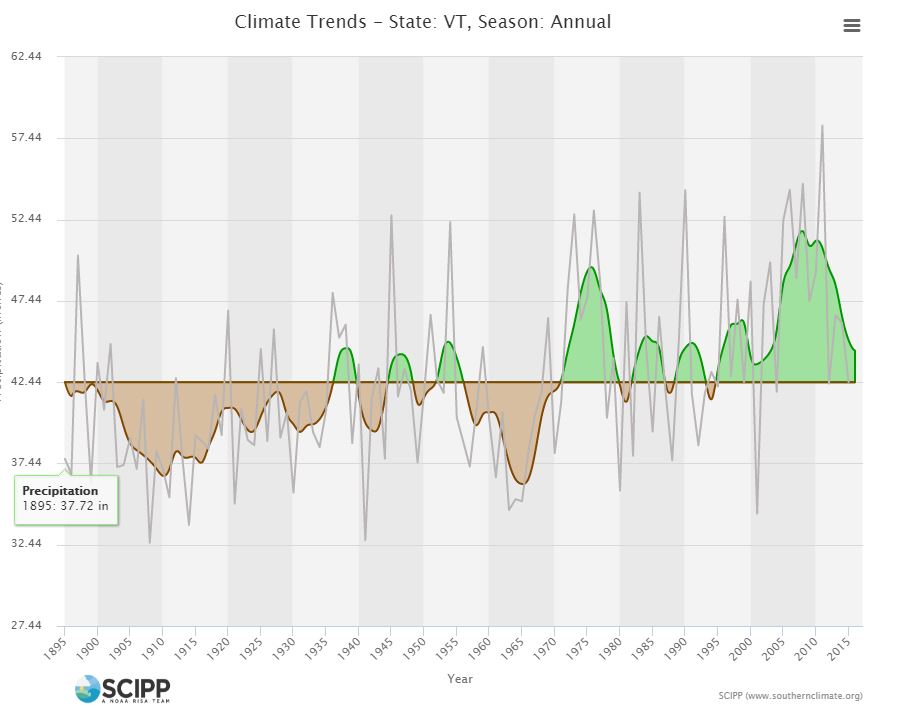Hazard Mitigation is sustained action taken to reduce or eliminate long-term risk to people and their property from hazards.
Links to sections below:
- FEMA Hazard Mitigation Assistance (HMA)
- Hazard Mitigation Grant Program (HMGP)
- Building Resilient Infrastructure and Communities (BRIC)
- Flood Mitigation Assistance (FMA)
- VEM Hazard Mitigation Assistance
- Flood Resilient Communities Fund (FRCF)
- Purpose of the Hazard Mitigation Grant Program
- How Much Funding is Available under HMGP?
- Important – Benefit Cost Analysis Waiver
FEMA Hazard Mitigation Assistance (HMA) currently includes three programs:
Hazard Mitigation Grant Program (HMGP) assists in implementing long-term hazard mitigation measures following a major disaster. This program is administered by the Vermont Emergency Management (VEM) Hazard Mitigation Program. VEM has information about HMGP funding opportunities, deadlines, training, and resources. Typically this funding is available to eligible projects across the state. While the money only follows after a disaster it is the most accessible funding for most purposes. This program can also fund the preparation of a Local Hazard Mitigation Plan.
Building Resilient Infrastructure and Communities (BRIC) provides funds for hazard mitigation planning and projects on an annual basis. This fund can support larger projects and is competitive on a national basis.
Flood Mitigation Assistance (FMA) provides funds for projects to reduce or eliminate risk of flood damage to buildings that are insured under the National Flood Insurance Program (NFIP). This fund has been under-used in Vermont but may be particularly helpful now that FEMA has waived the need for a Benefit-Cost Analysis for many elevation or acquisition projects.
Swift Current This program focuses on NFIP-insured structures that have had Repetitive Losses or Substantial Damage. The program is released after a federally declared disaster and provides funds for project scoping and implementation. Policy holders may be contacted through VEM or self-identify during post-disaster assessments. The community can also request a list from the NFIP through a Data Sharing Agreement with FEMA Region 1. Here are the Repetitive Loss numbers by community 10/2024: Repetitive Losses _ BCX Claims_10-17-2024.pdf Programs to mitigate structures with repetitive losses are additionally credited for Community Rating System (CRS) communities.
Vermont Emergency Management Hazard Mitigation Assistance
If you are considering a project for HMA funds contact the Vermont Hazard Mitigation Program at Vermont Emergency Management (VEM). The VEM Mitigation Team supports other state agencies, non-profits, Regional Planning Commissions and municipalities in applying for and implementing FEMA Hazard Mitigation Grant Program (HMGP) projects. VEM also supports regional planners and municipalities in preparing Local Hazard Mitigation Plans (LHMP) and Local Emergency Management Plans (LEMP).
VEM resources include:
- Acquisition Projects
- Infrastructure Projects
- Planning and 5% Initiative Projects
- Benefit-Cost Analysis
- Vermont Flood Resilient Communities Fund
Your HMA proposal may also find critical support from your Regional Planning Commission. If your Local Hazard Mitigation Plan (LHMP) has identified priorities for action it would be best to prepare HMGP applications ahead of time in anticipation of funds becoming available later.
While HMGP and PDM programs can fund the preparation of a Local Hazard Mitigation Plan – for all other purposes the community needs to have a LHMP in effect to receive funds under the program. Check your community’s LHMP status here.
Purpose of the Hazard Mitigation Grant Program
• Significantly reduce or permanently eliminate future risk to lives and property from natural hazards
• Provide funds to implement projects in accordance with priorities identified in State, Tribal, or local hazard mitigation plans
• Enable mitigation measures to be implemented during the recovery from a disaster
How Much Funding is Available under HMGP?
 HMGP funding is available after a federally- declared disaster. The amount of funding available, as well as the application deadlines are posted by VEM.
HMGP funding is available after a federally- declared disaster. The amount of funding available, as well as the application deadlines are posted by VEM.
HMGP funding is allocated to the state using a “sliding scale” formula based on the percentage of funds spent on Public and Individual Assistance for each declared disaster. For States like Vermont with a FEMA-approved Standard State Mitigation Plan, the formula provides for up to 15% of the first $2 billion of estimated aggregate amounts of disaster assistance, up to 10% for amounts between $2 billion and $10 billion, and 7.5% for amounts between $10 billion and $35 billion. For States with a FEMA-approved Enhanced Mitigation Plan, up to 20% of the total of Public and Individual Assistance funds authorized for the disaster (up to $35 billion of such assistance) are available.
HMGP funds may be used to pay up to 75% of the eligible project costs. The non-Federal match does not need to be cash; in-kind services or materials may be used. Funding from other federal sources cannot be used for the 25 percent share with one exception. Funding provided to states under the Community Development Block Grant program from the Department of Housing and Urban Development can be used to meet the non-federal share requirement.
In November 1988, the Robert T. Stafford Disaster Relief and Emergency Assistance Act established the Hazard Mitigation Grant Program. HMGP funds have been used to replace under-sized culverts and reduce localized flooding. These projects require a documented history of damage and a Benefit Cost Analysis.
Important – Benefit Cost Analysis Waiver
- FEMA waived the need for a BCA for acquisitions in the SFHA less than $775,411 (10/2024).
- In census tracks with low incomes, the new BCA tool adjusts the replacement cost of structures,
- Other projects have pre-calculated benefits that no longer require a BCA analysis, and
- FEMA BCA assistance is available to disadvantaged communities and Tribal Nations.
Review the BCA policy updates or access the toolkit
These changes reflect in part a shift in the discount rate to 3.1% from 7% aligned with updated federal guidance A-94 Circular, Guidelines and Discount Rates for Benefit Cost Analysis of Federal Programs, released by the White House Office of Management and Budget (OMB).
Hazard Mitigation Grant Program Appeals Database - tracks the status of appeals under this grant program.
Hazard Mitigation Assistance Program Digest - summary reference on HMA grant programs.
For more information about FEMA Hazard Mitigation Assistance contact: Vermont Hazard Mitigation Program at VEM.





